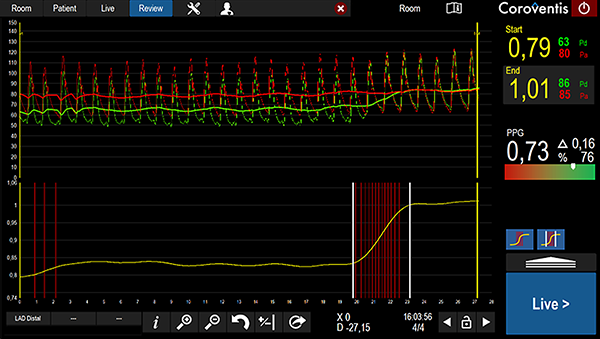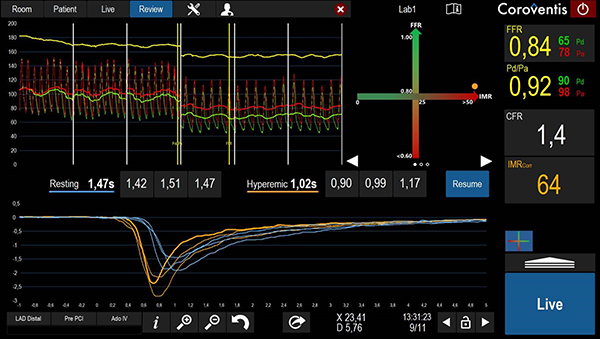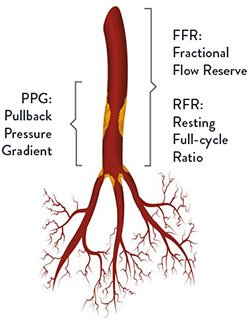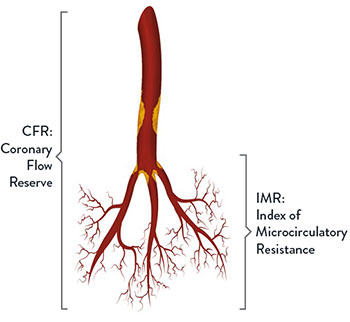CoroFlow‡ Software v3.7 offers Full Physiology insights, now enhanced with PPG1
- Measure Pullback Pressure Gradient (PPG) to objectively quantify focal coronary artery disease allowing physicians to assess and help identify patients that are most likely to be angina-free post-PCI4
- PPG, available in FFR mode on CoroFlow‡ Software v3.7, is measured by conducting an FFR pullback
- PPG assessment also displays Δ (Delta FFR between cursors) and % (Percentage of vessel FFR drop between cursors)
- Tailored IMR/CFR workflow modes:
- Routine display of IMR/CFR values simplified for users new to Coronary Microvascular Dysfunction (CMD) assessment
- Advanced mode displays research indices
- Visualize data interpretation with Full Physiology Result Matrix
- Full physiology performance insights readily available within the Statistics tab to inform cath lab utilization decisions and hospital marketing


Full Physiology Hemodynamic Data For the Entire Coronary Vasculature
The CoroFlow‡ Cardiovascular System is an advanced platform to conduct a Full Physiology assessment encompassing both epicardial vessels and the microvasculature.1
- Perform FFR/RFR to assess the functional significance of epicardial lesions5
- Perform PPG to quantify epicardial disease as focal or diffuse6
- For patients with persistent angina and no obstructive coronary artery diseases, measure IMR and CFR to assess for CMD7
- This system is designed specifically to communicate with the wireless PressureWire™ X Guidewire1,2
The CoroFlow‡ Cardiovascular System is capable of calculating and displaying hemodynamic measurements in both epicardial vessels and coronary microvasculature.1 Moreover, 50-65% of patients with angina with non-obstructive coronary artery disease (NOCAD) are believed to have CMD.8 Give patients a clear diagnosis of CMD and take the first step to improve their quality of life.7
CoroFlow‡ Cardiovascular System provides physiology data for vessel characteristics throughout the entire coronary vasculature.1
Determing the need for revascularization

Diagnosing Microvascular Disease

Questions?
We are proud of the quality of our products and services, and remain committed to providing exceptional support and assistance to our customers across the globe.
For ordering information, visit ordering.
For technical issues, answers to frequently asked questions of a technical nature, and troubleshooting options, visit support.
*As compared to all commercially available full physiology solutions outside of the U.S. as of Q2, 2025. Refer to IFUs for additional information. Full physiology refers to: Fractional Flow Reserve (FFR), Resting Full-cycle Ratio (RFR), Index of Microcirculatory Resistance (IMR), Coronary Flow Reserve (CFR) and Pullback Pressure Gradient (PPG). Data on file at Abbott.
References
- CoroFlow‡ Cardiovascular System Instructions for Use (IFU). Refer to IFU for additional information.
- PressureWire™ X Guidewire Instructions for Use (IFU). Refer to IFU for additional information.
- Data on file at Abbott.
- Collet C, et al. Differential Improvement in Angina and Health-Related Quality of Life After Percutaneous Coronary Interventions in Focal and Diffuse Coronary Artery Disease. J Am Coll Cardiol Intv. 2022.
- Pijls, NH., et al. Measurement of Fractional Flow Reserve to assess functional severity of coronary-artery stenosis. N Engl J Med. 1996;334(26):1703-1708.
- Collet C, et al, Influence of Pathophysiologic Patterns of Coronary Artery Disease on Immediate Percutaneous Coronary Intervention Outcomes. Circulation. 2024;140(12):1234-1245.
- Ford TJ, et al. 1-year outcomes of angina management guided by invasive coronary function testing (CorMicA). JACC Intv. 2020;13:33-45.
- Marinescu MA et al. Coronary microvascular dysfunction and microvascular angina: a systematic review of therapies. JACC Cardiovasc Imaging. 2015;8:210-22.
MAT-2004561 v4.0
